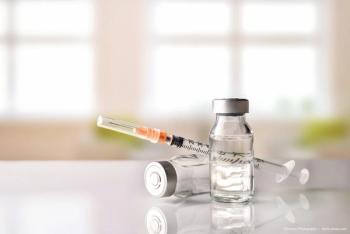
Newer functional tests add value for glaucoma detection, management
Although the perfect test for assessing glaucomatous functional damage is not yet available, newer perimetric methods seem to offer some advantages relative to standard automated perimetry (SAP) and utility in particular situations.
Robert Stamper, MD, professor of ophthalmology and director of the glaucoma service, University of California San Francisco, discussed the limitations of SAP, features of selective perimetry techniques that test the function of specific subpopulations of ganglion cells, and multifocal, visual-evoked potential testing, which represents one attempt at objective perimetry.
The search for new techniques to measure glaucoma-related, functional damage is being driven in part by the various drawbacks of SAP, said Dr. Stamper, whose presentation was entitled, “New Visual Function Testing in Glaucoma.”
“SAP is difficult for patients to perform and time-consuming,” Dr. Stamper said. ”Furthermore, the results of SAPs are highly variable, the testing platform is not easily portable, and SAP is not sensitive enough to detect the earliest glaucomatous damage–as we know that between 25% and 35% of ganglion cells have to be lost before the first evidence of white-on-white, perimetric damage is manifest.”
Short-wavelength auto perimetry (SWAP), also known as blue-yellow perimetry, was first described almost a century ago and became the subject of renewed interest during the 1990s, based on evidence that a blue stimulus on a yellow background seemed to segregate out a subgroup of the parvocellular (P) ganglion cells. However, its use has fallen off over the last four to five years and it may disappear altogether based on realization of the test’s limitations.
“Compared to SAP, SWAP has a longer learning curve, greater variability, and takes 15% to 20% longer to complete, even with application of a SITA algorithm,” Dr. Stamper explained. “Furthermore, SWAP is more sensitive to nuclear lens changes than SAP, and it is also affected by yellow-tinted IOLs.”
“Additionally, while results from two longitudinal studies, which were conducted at academic institutions, suggested SWAP had higher sensitivity than SAP and detected progression earlier, those findings have not been borne out by more recent studies or experience in clinical practice.”
Frequency-doubled perimetry (FDP) tests a subset of the magnocellular (M) ganglion cells that are related to motion detection. Evaluations of FDP using the originally developed device showed the testing was relatively insensitive to refractive errors or ambient light levels, and had a minimal learning curve, high sensitivity and specificity (~90%), and good test-retest reliability.
The currently available device based on frequency-doubling technology (FDT, Humphrey Matrix, Carl Zeiss Meditec) is a more sophisticated platform. It uses an algorithm that allows relatively rapid visual field sensitivity testing and has both a screening program that performs well for detecting glaucoma and a threshold program that is as good as SAP for monitoring patients.
Dr. Stamper proposed that FDT may be particularly useful for screening because of its portability and reasonably high sensitivity and specificity, and also when performing functional testing in children and older individuals.
“Compared with SAP, FDT is faster and is more positive in terms of the sensation, and so it is able to give more reliable results in these groups of patients who may have trouble performing SAP,” he said.
However, FDT has some limitations.
“Although its specificity is relatively high, there is still a 10% false positive rate, at least on the first test, and it sometimes misses glaucoma that is picked up by other tests, although it is similar in that respect to SAP,” he added. “The testing is also sensitive to decreased retinal illumination, and so the results may be affected by cataract.”
High-pass resolution perimetry involves projection of rings of different sizes onto the visual field and is based on function of the parvocellular ganglion cells. This test has good sensitivity and specificity, is fast and easy to perform, and has good test-retest reliability. It must be done using specialized lenses, but an ongoing patent fight is the main factor limiting its development for commercial availability.
Motion-automated perimetry (MAP) tests for the function of magnocellular ganglion cells. It is done with a laptop, and findings from initial testing done at University of California, San Francisco, and Moorfields Eye Hospital, London, UK, suggest MAP has good patient acceptance and has features that can make it attractive as a screening tool.
“The patients liked the test much better than SAP, and it seemed to perform well for detecting and following moderate to advanced glaucoma,” Dr. Stamper reported. “Although MAP was not as sensitive as we would like it to be for identifying early disease, given its portability and ease, MAP may still have some value as a population screening test.”
Multifocal, visual-evoked potential testing (Accumap, Objectivision) is an objective perimetry method based on analysis of an electroencephalogram of the visual cortex following retinal stimulation. It has been shown effective for discriminating glaucoma patients from normal subjects, but long-term studies and change parameters are lacking. Like high-pass resolution perimetry, the technology for multifocal, visual-evoked potential testing also has been the subject of a patent dispute that may limit its commercial application. However, another company is currently working on developing similar technology.
Two tests may be better than one
Dr. Stamper noted that while refinements of some of the newer functional tests may improve glaucoma diagnosis and management in the future, use of tests in combination might bring advances. For example, a 97% glaucoma detection rate was reported using SWAP and FDP together.
“However, the duration of testing using both functional assessments is much too long to be practical, and combining FDP with a structural test may be better,” Dr. Stamper said.
FYI
Robert Stamper, MD, has no financial interest in any of the products he discussed.
Photo caption:
Patient takes the motion-automated perimetry test (MAP). MAP tests for the function of magnocellular ganglion cells. The test is performed with a laptop, and findings from initial testing suggest MAP has good patient acceptance and has features that can make it attractive as a screening tool.
Callout
‘SAP is difficult for patients to perform and time-consuming.’
Robert Stamper, MD
Newsletter
Don’t miss out—get Ophthalmology Times updates on the latest clinical advancements and expert interviews, straight to your inbox.



















































.png)


